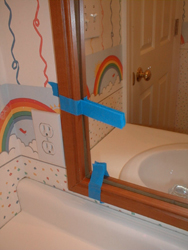Dress Up a Plain Mirror

Dress Up a Plain Mirror | Applying wood trim around a plain flat mirror is a simple task. The end results, however, are anything but ordinary. Photo credit: Tim Carter
DEAR TIM: I have a 40 inch high by 60 inch wide plate glass mirror in my bathroom. My wife wants to dress up the mirror and asked me if I could frame the mirror with wood trim. I said I could before thinking it through. Is it possible to do this? How would you frame this mirror? Is it safe to do? Carl R., Fayetteville, NC
DEAR CARL: Gosh, I thought I was the only one who spoke too soon. But my wife Kathy knows better - she knows if she can dream it, I can usually do it. In your case, you dodged the bullet. Transforming the plain float glass mirror into an asset within the bathroom is not very difficult. To achieve excellent results, you will need to do some work ahead of time.
What type of wood should be used to frame a mirror?
Depending upon the tools you own and your skill level, you have two basic options with respect to the type of wood you will use. Perhaps the simplest wood frame would be a flat piece of wood that covers the outer edge of the mirror. When you look straight at the mirror, you will get the desired wood-frame look. But this method does not cover the actual edge of the glass mirror. Your wife may not mind but I can tell you that Kathy would want that edge covered as well.
What is a rabbet cut?
To do this, you need to use a piece of wood that has been cut with a rabbet on the underside. This rabbet allows the wood to overlap the edge of the mirror and hide the edge of the glass. The depth of the rabbet equals or slightly exceeds the thickness of the mirror. Many traditional lumber yards often have decorative wood moldings that have this rabbeted profile. You may be able to find one or more pieces of trim that are ready to miter. If not, you can create a rabbet profile with a standard table saw. Be sure to buy or make a small amount of trim for testing purposes. I will describe that in a few moments.
When do you prefinish the wood trim?
Once you have the necessary wood trim, you need to prefinish it before you attach it to the mirror. Finish the test piece of trim with the rest of the wood. Failure to do this may lead to an undesirable look as you look closely where the wood ends and the mirror begins. The reflectivity of the mirror will allow you to see the first one eighth inch or so of the under side of the wood trim. For example, if you were to stain a light wood a dark color, you would end up with a light colored racing stripe around the interior of the wood frame. This same thing can happen if you paint the wood trim a medium or dark color.
Once you have prefinished the wood trim, it is a good idea to let the finish cure for a minimum of two weeks. This wait time will help insure there is no adverse reaction between the paint or urethane and the adhesive that will be used to hold the wood to the glass mirror.
How do you attach the wood to the mirror?
I prefer to use clear fast-setting epoxy when attaching wood to glass. This durable adhesive can often be found at a hardware store or home center. When you are buying the adhesive, purchase or obtain a small piece of clear glass at the same time. You will use the test piece of trim, the epoxy and the scrap glass to see how well the epoxy works.
Follow the directions on the epoxy and mix as directed. Apply a thin coat to the back of the wood trim and tape it to the scrap glass. Use the special low strength painter's tape for this task. Do not use aggressive regular masking tape.
CLICK or TAP HERE to get FREE quotes from Local Glass & Mirrors Services.
Wait the required time for the epoxy to cure and test to see if the wood trim is securely fastened to the glass. If all is well, proceed to epoxy the wood trim to the mirror. Take your time and do not use too much epoxy. You do not want any epoxy to drip down onto the face of the finished mirror.